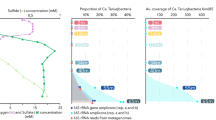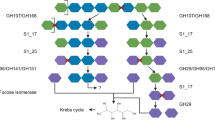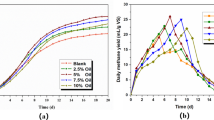Abstract
The thermophilic sulfate-reducing archaeon Archaeoglobus fulgidus strain VC-16 (DSM 4304), which is known to oxidize fatty acids and n-alkenes, was shown to oxidize saturated hydrocarbons (n-alkanes in the range C10–C21) with thiosulfate or sulfate as a terminal electron acceptor. The amount of n-hexadecane degradation observed was in stoichiometric agreement with the theoretically expected amount of thiosulfate reduction. One of the pathways used by anaerobic microorganisms to activate alkanes is addition to fumarate that involves alkylsuccinate synthase as a key enzyme. A search for genes encoding homologous enzymes in A. fulgidus identified the pflD gene (locus-tag AF1449) that was previously annotated as a pyruvate formate lyase. A phylogenetic analysis revealed that this gene is of bacterial origin and was likely acquired by A. fulgidus from a bacterial donor through a horizontal gene transfer. Based on three-dimensional modeling of the corresponding protein and molecular dynamic simulations, we hypothesize an alkylsuccinate synthase activity for this gene product. The pflD gene expression was upregulated during the growth of A. fulgidus on an n-alkane (C16) compared with growth on a fatty acid. Our results suggest that anaerobic alkane degradation in A. fulgidus may involve the gene pflD in alkane activation through addition to fumarate. These findings highlight the possible importance of hydrocarbon oxidation at high temperatures by A. fulgidus in hydrothermal vents and the deep biosphere.
Similar content being viewed by others
Log in or create a free account to read this content
Gain free access to this article, as well as selected content from this journal and more on nature.com
or
Accession codes
References
Altschul SF, Madden TL, Schäffer AA, Zhang J, Zhang Z, Miller W et al. (1997). Gapped BLAST and PSI-BLAST: a new generation of protein database search programs. Nucleic Acids Res 25: 3389–3402.
Beeder J, Nilsen RK, Rosnes JT, Torsvik T, Lien T . (1994). Archaeoglobus fulgidus isolated from hot North Sea oil field waters. Appl Environ Microbiol 60: 1227–1231.
Beller HR, Spormann AM . (1998). Analysis of the novel benzylsuccinate synthase reaction for anaerobic toluene activation based on structural studies of the product. J Bacteriol 180: 5454–5457.
Boll M, Fuchs G, Heider J . (2002). Anaerobic oxidation of aromatic compounds and hydrocarbons. Curr Opin Chem Biol 6: 604–611.
Boll M, Heider J . (2010). Anaerobic degradation of hydrocarbons: Mechanisms of C-H-bond activation in the absence of oxygen. In: Timmis KN, (ed). Handbook of Hydrocarbon and Lipid Microbiology. Springer-Verlag: Berlin, Heidelberg, pp 1011–1024.
Brezovsky J, Chovancova E, Gora A, Pavelka A, Biedermannova L, Damborsky J . (2012). Software tools for identification, visualization and analysis of protein tunnels and channels. Biotechnol Adv 31: 38–49.
Brochier-Armanet C, Forterre P, Gribaldo S . (2011). Phylogeny and evolution of the Archaea: one hundred genomes later. Curr Opin Microbiol 14: 274–281.
Brooks BR, Brooks CL 3rd, Mackerell AD Jr, Nilsson L, Petrella RJ, Roux B et al. (2009). CHARMM: the biomolecular simulation program. J Comput Chem 30: 1545–1614.
Callaghan AV . (2013). Enzymes involved in the anaerobic oxidation of n-alkanes: from methane to long-chain paraffins. Front Microbiol 4: 89.
Callaghan AV, Davidova IA, Savage-Ashlock K, Parisi VA, Gieg LM, Suflita JM et al. (2010). Diversity of benzyl- and alkylsuccinate synthase genes in hydrocarbon-impacted environments and enrichment cultures. Environ Sci Technol 44: 7287–7294.
Callaghan AV, Gieg LM, Kropp KG, Suflita JM, Young LY . (2006). Comparison of mechanisms of alkane metabolism under sulfate-reducing conditions among two bacterial isolates and a bacterial consortium. Appl Environ Microbiol 72: 4274–4282.
Callaghan AV, Morris BEL, Pereira IAC, McInerney MJ, Austin RN, Groves JT et al. (2012). The genome sequence of Desulfatibacillum alkenivorans AK-01: a blueprint for anaerobic alkane oxidation. Environ Microbiol 14: 101–113.
Callaghan AV, Wawrik B, Chadhain SMN, Young LY, Zylstra GJ . (2008). Anaerobic alkane-degrading strain AK-01 contains two alkylsuccinate synthase genes. Biochem Biophys Res Commun 366: 142–148.
Champion KM, Zengler K, Rabus R . (1999). Anaerobic degradation of ethylbenzene and toluene in denitrifying strain EbN1 proceeds via independent substrate-induced pathways. J Molec Microbiol Biotechnol 1: 157–164.
Chen C-I, Taylor RT . (1997). Thermophilic biodegradation of BTEX by two consortia of anaerobic bacteria. Appl Microbiol Biotechnol 48: 121–128.
Chovancova E, Pavelka A, Benes P, Strnad O, Brezovsky J, Kozlikova B et al. (2012). CAVER 3.0: a tool for the analysis of transport pathways in dynamic protein structures. PLoS Comput Biol 8: e1002708.
Cline JD . (1969). Spectrophotometric determination of hydrogen sulfide in natural waters. Limnol Oceanogr 14: 454–458.
Coates JD, Woodward J, Philip P, Lovley DR . (1997). Anaerobic degradation of polycyclic aromatic hydrocarbons and alkanes in petroleum-contaminated marine harbor sediments. Appl Environ Microbiol 63: 3589–3593.
Coschigano PW, Wehrman TS, Young LY . (1998). Identification and analysis of genes involved in anaerobic toluene metabolism by strain T1: putative role of a glycine free radical. Appl Environ Microbiol 64: 1650–1656.
Cravo-Laureau C, Grossi V, Raphel D, Matheron R, Hirschler-Réa A . (2005). Anaerobic n-alkane metabolism by sulfate-reducing bacterium, Desulfatibacillum aliphaticivorans strain CV2803T. Appl Environ Microbiol 71: 3458–3467.
Criscuolo A, Gribaldo S . (2010). BMGE (Block Mapping and Gathering with Entropy): a new software for selection of phylogenetic informative regions from multiple sequence alignments. BMC Evol Biol 10: 210.
DeLano WL . (2005). The case for open-source software in drug discovery. Drug Discov Today 10: 213–217.
Fardeau ML, Goulhen F, Bruschi M, Khelifi N, Cayol JL, Ignatiadis I et al. (2009). Archaeoglobus fulgidus and Thermotoga elfii, thermophilic isolates from deep geothermal water of the Paris basin. Geomicrobiol J 26: 119–130.
Gouy M, Guindon S, Gascuel O . (2010). SeaView version 4: a multiplatform graphical user interface for sequence alignment and phylogenetic tree building. Mol Biol Evol 27: 221–224.
Grossi V, Cravo-Laureau C, Guyoneaud R, Ranchou-Peyruse A, Hirschler-Réa A . (2008). Metabolism of n-alkanes and n-alkenes by anaerobic bacteria: a summary. Org Geochem 39: 1197–1203.
Grundmann O, Behrends A, Rabus R, Amann J, Halder T, Heider J et al. (2008). Genes encoding the candidate enzyme for anaerobic activation of n-alkanes in the denitrifying bacterium, strain HxN1. Environ Microbiol 10: 376–385.
Guindon S, Dufayard JF, Lefort V, Anisimova M, Hordijk W, Gascuel O . (2010). New algorithms and methods to estimate maximum-likelihood phylogenies: assessing the performance of PhyML 3.0. Syst Biol 59: 307–321.
Heider J . (2007). Adding handles to unhandy substrates: anaerobic hydrocarbon activation mechanisms. Curr Opin Chem Biol 11: 188–194.
Ho BK, Gruswitz F . (2008). HOLLOW: generating accurate representations of channel and interior surfaces in molecular structures. BMC Struct Biol 8: 49.
Holmes DE, Risso C, Smith JA, Lovley DR . (2011). Anaerobic oxidation of benzene by the hyperthermophilic archaeon Ferroglobus placidus. Appl Environ Microbiol 77: 5926–5933.
Jarling R, Sadeghi M, Drozdowska M, Lahme S, Buckel W, Rabus R et al. (2012). Stereochemical investigations reveal the mechanism of the bacterial activation of n-alkanes without oxygen. Angew Chem Int Ed 51: 1334–1338.
Jones DM, Head IM, Gray ND, Adams JJ, Rowan AK, Aitken CM et al. (2008). Crude-oil biodegradation via methanogenesis in subsurface petroleum reservoirs. Nature 451: 176–180.
Katoh K, Standley DM . (2013). MAFFT multiple sequence alignment software version 7: improvements in performance and usability. Mol Biol Evol 30: 772–780.
Khelifi N, Grossi V, Dolla A, Hamdi M, Tholozan J-L, Ollivier B et al. (2010). Anaerobic oxidation of fatty acids and alkenes by the hyperthemophilic sulfate-reducing archaeon, Archaeoglobus fulgidus. Appl Environ Microbiol 76: 3057–3060.
Klenk H-P, Clayton RA, Tomb J-F, White O, Nelson KE, Ketchum KA et al. (1997). The complete genome sequence of the hyperthermophilic, sulphate-reducing archaeon Archaeoglobus fulgidus. Nature 390: 364–370.
Knappe J, Elbert S, Frey M, Wagner AFV . (1993). Pyruvate formate lyase mechanism involving the protein-based glycyl radical. Biochem Soc Trans 21: 731–734.
Kniemeyer O, Musat F, Sievert SM, Knittel K, Wilkes H, Blumenberg M et al. (2007). Anaerobic oxidation of short-chain hydrocarbons by marine sulphate-reducing bacteria. Nature 449: 898–901.
Konn C, Charlou JL, Donval JP, Holm NG, Dehairs F, Bouillon S . (2009). Hydrocarbons and oxidized organic compounds in hydrothermal fluids from Rainbow and Lost City ultramafic-hosted vents. Chem Geol 258: 299–314.
Kropp KG, Davidova IA, Suflita JM . (2000). Anaerobic oxidation of n-dodecane by an addition reaction in a sulfate-reducing bacterial enrichment culture. Appl Environ Microbiol 66: 5393–5398.
L’Haridon S, Reysenbacht AL, Glenat P, Prieur D, Jeanthon C . (1995). Hot subterranean biosphere in a continental oil reservoir. Nature 377: 223–224.
Le SQ, Gascuel O . (2008). An improved general amino acid replacement matrix. Mol Biol Evol 25: 1307–1320.
Lehtiö L, Grossmann JG, Kokona B, Fairman R, Goldman A . (2006). Crystal structure of a glycyl radical enzyme from Archaeoglobus fulgidus. J Mol Biol 357: 221–235.
Leuthner B, Leutwein C, Schulz H, Hörth P, Haehnel W, Schiltz E et al. (1998). Biochemical and genetic characterization of benzylsuccinate synthase from Thauera aromatica: a new glycyl radical enzyme catalysing the first step in anaerobic toluene metabolism. Mol Microbiol 28: 615–628.
Liang J, Edelsbrunner H, Woodward C . (1998). Anatomy of protein pockets and cavities: measurement of binding site geometry and implications for ligand design. Protein Sci 7: 1884–1897.
MacKerell AD, Feig M, Brooks CL . (2004). Improved treatment of the protein backbone in empirical force fields. J Amer Chem Soc 126: 698–699.
Magot M, Ollivier B, Patel BKC . (2000). Microbiology of petroleum reservoirs. Antonie van Leeuw 77: 103–116.
Mardanov AV, Ravin NV, Svetlitchnyi VA, Beletsky AV, Miroshnichenko ML, Bonch-Osmolovskaya EA et al. (2009). Metabolic versatility and indigenous origin of the archaeon Thermococcus sibiricus, isolated from a Siberian oil reservoir, as revealed by genome analysis. Appl Environ Microbiol 75: 4580–4588.
Mbadinga SM, Li K-P, Zhou L, Wang L-Y, Yang S-Z, Liu J-F et al. (2012). Analysis of alkane-dependent methanogenic community derived from production water of a high-temperature petroleum reservoir. Appl Microbiol Biotechnol 96: 1–12.
Miroshnichenko M, Hippe H, Stackebrandt E, Kostrikina N, Chernyh N, Jeanthon C et al. (2001). Isolation and characterization of Thermococcus sibiricus sp. nov. from a Western Siberia high-temperature oil reservoir. Extremophiles 5: 85–91.
Ollivier B, Alazard D . (2010). The oil reservoir ecosystem. In: Timmis KN (ed). Handbook of Hydrocarbon and Lipid Microbiology. Springer-Verlag: Berlin, Heidelberg, pp 2261–2269.
Petrek M, Otyepka M, Banás P, Kosinová P, Koca J, Damborský J . (2006). CAVER: a new tool to explore routes from protein clefts, pockets and cavities. BMC Bioinformatics 7: 316.
Pfaffl MW . (2001). A new mathematical model for relative quantification in real-time RT-PCR. Nucleic Acids Res 29: 2002–2007.
Price MN, Dehal PS, Arkin AP . (2010). FastTree 2 – approximately maximum-likelihood trees for large alignments. PLoS One 5: e9490.
Rabus R, Wilkes H, Behrends A, Armstroff A, Fischer T, Pierik AJ et al. (2001). Anaerobic initial reaction of n-alkanes in denitrifying bacterium: evidence for (1-methylpentyl)succinate as initial product and for involvement of an organic radical in n-hexane metabolism. J Bacteriol 183: 1707–1715.
Rojo F . (2009). Degradation of alkanes by bacteria. Environ Microbiol 11: 2477–2490.
Ronquist F, Teslenko M, van der Mark P, Ayres DL, Darling A, Höhna S et al. (2012). MrBayes 3.2: efficient Bayesian phylogenetic inference and model choice across a large model space. Syst Biol 61: 539–542.
Rueter P, Rabus R, Wilkes H, Aeckersberg F, Rainey FA, Jannash HW et al. (1994). Anaerobic oxidation of hydrocarbons in crude oil by new types of sulphate-reducing bacteria. Nature 372: 455–457.
Sofia HJ, Chen G, Hetzler BG, Reyes-Spindola JF, Miller NE . (2001). Radical SAM, a novel protein superfamily linking unresolved steps in familiar biosynthetic pathways with radical mechanisms: functional characterization using new analysis and information visualization methods. Nucleic Acids Res 29: 1097–1106.
Stetter KO . (1988). Archaeoglobus fulgidus gen. nov., sp. nov.: a new taxon of extremely thermophilic archeabacteria. System Appl Microbiol 10: 172–173.
Stetter KO, Huber R, Blochl E, Kurr M, Eden RD, Fielder M et al. (1993). Hyperthermophilic archaea are thriving in deep North Sea and Alaskan oil reservoirs. Nature 365: 743–745.
Stetter KO, Lauerer G, Thomm M, Neuner A . (1987). Isolation of extremely thermophilic sulfate reducers - evidence for a novel branch of Archaebacteria. Science 236: 822–824.
Thauer RK, Jungermann K, Decker K . (1977). Energy conservation in chemotrophic anaerobic bacteria. Bacteriol Rev 41: 100–180.
Widdel F, Knittel K, Galushko A . (2010). Anaerobic hydrocarbon-degrading microorganisms: an overview. In: Timmis KN (ed). Handbook of Hydrocarbon and Lipid Microbiology. Springer-Verlag: Berlin, Heidelberg, pp 1998–2021.
Wolin EA, Wolin MJ, Wolfe RS . (1963). Formation of methane by bacterial extracts. J Biol Chem 238: 2882–2886.
Zedelius J, Rabus R, Grundmann O, Werner I, Brodkorb D, Schreiber F et al. (2011). Alkane degradation under anoxic conditions by a nitrate-reducing bacterium with possible involvement of the electron acceptor in substrate activation. Environ Microbiol Rep 3: 125–135.
Zellner G, Stackebrandt E, Kneifel H, Messner P, Sleytr UB, Conway De Macario E et al. (1989). Isolation and characterization of a thermophilic, sulfate reducing Archaebacterium, Archaeoglobus fulgidus strain Z. System Appl Microbiol 11: 151–160.
Acknowledgements
This work was partially supported by a French CNRS-INSU grant to V. Grossi (BIOHYDEX EC2CO-Microbien project). C. Brochier-Armanet is supported by the Investissement d'Avenir grant Ancestrome (ANR-10-BINF-01-01) and is a member of the Institut Universitaire de France. We would like to thank the anonymous reviewers for allowing an opportunity to improve this manuscript.
Author information
Authors and Affiliations
Corresponding author
Ethics declarations
Competing interests
The authors declare no conflict of interest.
Additional information
Supplementary Information accompanies this paper on The ISME Journal website
Supplementary information
Rights and permissions
About this article
Cite this article
Khelifi, N., Amin Ali, O., Roche, P. et al. Anaerobic oxidation of long-chain n-alkanes by the hyperthermophilic sulfate-reducing archaeon, Archaeoglobus fulgidus. ISME J 8, 2153–2166 (2014). https://doi.org/10.1038/ismej.2014.58
Received:
Revised:
Accepted:
Published:
Issue date:
DOI: https://doi.org/10.1038/ismej.2014.58
Keywords
This article is cited by
-
A review on microbial diversity and genetic markers involved in methanogenic degradation of hydrocarbons: futuristic prospects of biofuel recovery from contaminated regions
Environmental Science and Pollution Research (2021)
-
Long-chain n-alkane biodegradation coupling to methane production in an enriched culture from production water of a high-temperature oil reservoir
AMB Express (2020)
-
Deciphering the archaeal communities in tree rhizosphere of the Qinghai-Tibetan plateau
BMC Microbiology (2020)
-
Novel clostridial lineages recovered from metagenomes of a hot oil reservoir
Scientific Reports (2020)
-
Divergent methyl-coenzyme M reductase genes in a deep-subseafloor Archaeoglobi
The ISME Journal (2019)



